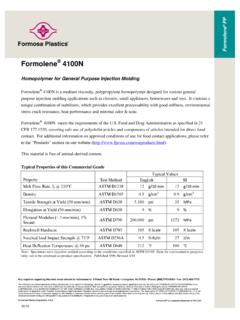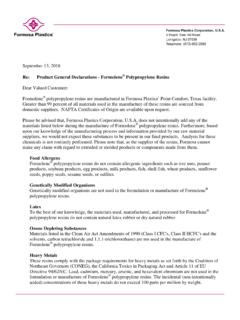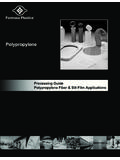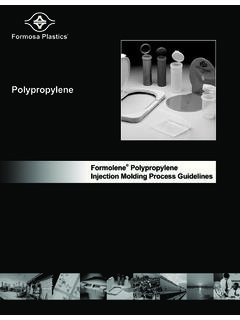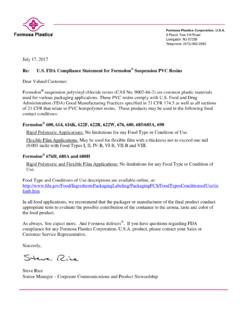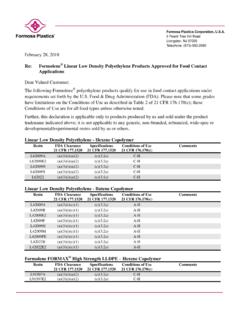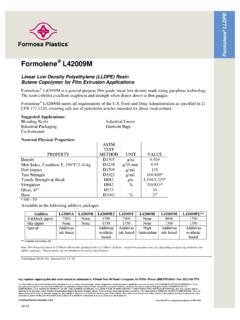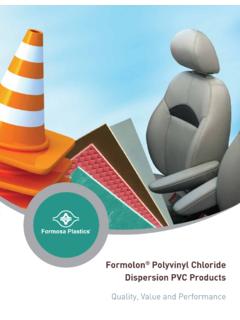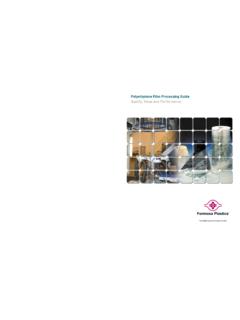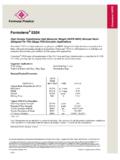Transcription of Polypropylene - Fpc USA
1 Processing GuidePolypropylene Fiber & Slit Film ApplicationsPolypropylene2 Processing GuidePolypropylene Fiber & Slit Film ApplicationsTypical Fiber & Extrusion Product PropertiesBCF(Medium MFR PP) (20)BCF (High MFR PP) (35)Slit Film(3-4 MFR)Straw(4-6 MFR) Staple Fibers (6-8 MFR)Denier~1800~600-1800---->500, Temperature ( C)230-240200-215220-240235230-240 Chill Roll Temperature ( C) ~ Ratio> > >6-8-->3 Polyolefinis a general term used to describe a family of polymers derived from a particular group of base chemicals The Polyolefin family includes Polypropylene , as well as polyethylene. Polypropylene is made by building up longchains of propylene monomers. Due to its inherent nature of chemical resistance, low density, outstanding property balance and process versatility, Polypropylene has a broad range of applications such as flexible fibers for carpet, carpet backing, and personal has two separate and unique gas phase Polypropylene polymerization processes.
2 These processes complimenteach other and yield high degree of isotacticity (for physical properties) and a degree of Xylene Soluble Extractables forsmooth and continuous processability. Formolene Polypropylene grades are used in a variety of extrusion applicationsincluding Slit Films, Strapping, Straws, CF & BCF, as well as unique non-woven staple fibers. Polypropylene grades for the fiber market sector range from reactor grade high MFR PPfor BCF in rugs and carpets, tostaple for geotextiles and non-wovens, to slit tape for raffia and strapping applications, to Controlled Rheology PP grades forfine denier upholstery yarns. Details of each grade can be found at Fiber & Extrusion GradesApplicationsGradeCommentsSlit Tapes1102KR, 1102L, 1103K, 1112 HExcellent Water CarryoverBCF-Face yarn4101 OExcellent Gas FadingCarpet Backing1102KR & 1102 KExcellent Shrinkage & ProcessibilityCF Yarn & Geotextlies5101 MExcellent UV ResistanceCordage & Rope1102H & 1102 KRExcellent Thermal Stability & StrengthNetting1102K & 5181 KExcellent grade for thin gauge Staple Fibers4101 MExcellent balance of tenacity & softness for consumer products Strapping5100 HFractional MFR Homopolymer PPCompounding Profile(Large Part Extrusion)
3 6501 ALow MFR Copolymer6600 AFractional MFR CopolymerStraws5181 KHomopolymer PP3 Processing GuidePolypropylene Fiber & Slit Film ApplicationsSlit Film ApplicationsProblems ObservedPossible CausesCorrective ActionsExcessive WaterCarryover Processing temperature too high Water Quench bath temperature too high Adjust the temperature profile in extruder zones Lower the quench tank temperature Review the concentrate & regrind level Rearrange the mechanical brush positions. Slow Down the speedTape/yarn breakage Melt Temperature too low Godet temperature too low Draw speed too high Up the melt temp & optimize the extruder temperatureprofile; also review the godet temperature . Review the A/O level in PP Alter the draw ratio Check the regrind Shrinkage Heat set temperature too low Draw ratio too high Alter the draw roll temp.
4 To reflect higher settemperature. Reduce the draw Tenacity PP-MFR too high Residual elongation Review the MFR of the starting PP; In general, thelower the MFR->higher the tenacity, however at theexpense of higher back-pressure. Adjust (^) the draw ratio. Lower the draw Continuous Filaments ApplicationsProblems ObservedPossible CausesCorrective ActionsYarn Breakage Draw ratio too high Godet Temperature too low Process Temperature too low Either increase the godet temperature or reduce thedraw ratio. Optimize the temperature profile Check the A/O level in resin Check the color concentration level Alter the spin draw temperatureColor of the filaments Improper mixing of the components(concentration + resin) Process temperature too high Check the compatibility of two components from MFR Check the additive levels Pre-blend PPwith concentrateLow Tenacity PP-MFR too high Process Temperature too high Attempt slightly lower MFR Check the A/O levels Increase the draw ratio Alter process & spin draw temperaturesBulk Characteristic Heat setting temp.
5 Too low Tension in the final region too high Increase the heat set tempurature Alter process/SD temperature9 Peach Tree Hill Road, Livingston, NJ 07039 2006 Formosa Plastics Corporation, : June 2006
